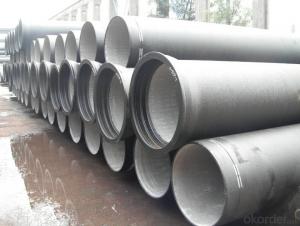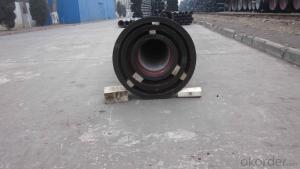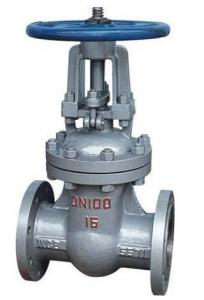DUCTILE IRON PIPE DN1200
- Loading Port:
- China Main Port
- Payment Terms:
- TT OR LC
- Min Order Qty:
- -
- Supply Capability:
- -
OKorder Service Pledge
OKorder Financial Service
You Might Also Like
Specification:
1) The standard of pipe: ISO2531:1998, K9
2) Effective length: 6m
3) Inner cement line: Portland cement line as per ISO4179
4) Zinc coating: at least 130g/m2 as per ISO8179
5) Bitumen painting: at least 70um as per ISO8179
6) With 100% quantity of NBR ring, or SBR ring, or EPDM ring as per ISO4633
7) DN80mm-800mm
8) High strength, lighter than grey iron, good corrosion resistance, no furring, small flow resistance, easy fixing, long life tome about 100 yeas
9) Produced by Hangzhou chunfeng machine
10) Checked by automatic inspection equipment
11) Composition:
Chemical composition | |||
Chemical composition | Ductile Cast Iron Pipe (%) | Grey iron pipe (%) | Steel pipe (%) |
C | 3.5-4.0 | 3.2-3.8 | 0.1-0.2 |
Si | 1.9-2.6 | 1.4-2.2 | 0.15-0.4 |
Mn | 0.15-0.45 | 0.4-0.6 | 0.3-0.6 |
P | ≤0.06 | ≤0.3 | 0.02-0.03 |
S | ≤0.02 | ≤0.1 | 0.02-0.03 |
Mg | 0.03-0.06 |
|
|
12) Feature:
Mechanical properties | |||
| Ductile Cast Iron Pipe | Grey Iron Pipe | Steel Pipe |
Tensile Strength(Mpa) | ≥420 | 150-260 | ≥400 |
Yield Strength(Mpa) | ≥300 | No Confirmation | No Confirmation |
Bending Strength(Mpa) | ≥590 | 200-360 | ≥400 |
Elongation (%) | ≥10 | Neglected | ≥18 |
Brinell Hardness(HBS) | ≤230 | ≤230 | About 140 |
13) T type mechanical joint
14) Packing: in bulk or container
- Q:Can ductile iron pipes be used for railway bridges?
- Yes, ductile iron pipes can be used for railway bridges. Ductile iron is a type of strong and durable cast iron that has excellent tensile strength and flexibility. These properties make it suitable for various applications, including railway bridges. Ductile iron pipes can be used to construct railway bridge components such as supports, beams, and columns. They provide structural stability and can withstand heavy loads and vibrations associated with railway traffic. Additionally, ductile iron pipes are resistant to corrosion, which is crucial for railway bridges exposed to outdoor conditions. Therefore, ductile iron pipes are a viable option for railway bridge construction.
- Q:What is the composition of ductile iron pipes?
- Ductile iron pipes are primarily composed of iron, with small amounts of carbon, silicon, manganese, and trace elements such as sulfur and phosphorus.
- Q:How long do ductile iron pipes last?
- Ductile iron pipes are known for their durability and long lifespan. On average, these pipes can last anywhere between 80 to 100 years, with some even lasting up to 150 years. The longevity of ductile iron pipes is attributed to their robust construction, which enables them to withstand high-pressure environments, resist corrosion, and endure extreme weather conditions. Additionally, ductile iron pipes have a proven track record of reliability and performance, making them a popular choice for water and wastewater infrastructure projects worldwide. Regular inspection and maintenance can further extend the lifespan of ductile iron pipes, ensuring their continued service for many decades.
- Q:Are ductile iron pipes suitable for use in chemical storage tanks?
- Ductile iron pipes are not suitable for use in chemical storage tanks. While ductile iron pipes have excellent mechanical properties, including high tensile strength and impact resistance, they are not resistant to corrosion caused by various chemicals. Chemical storage tanks require materials that can withstand the corrosive properties of the stored chemicals to ensure the safety and integrity of the tank. Therefore, materials such as fiberglass-reinforced plastic (FRP), stainless steel, or high-density polyethylene (HDPE) are commonly used for chemical storage tanks due to their superior corrosion resistance. It is crucial to select the appropriate material for chemical storage tanks to prevent leaks, contamination, and potential hazards.
- Q:The benefits of ductile iron castings
- Nodular cast iron has developed rapidly to be second only to grey cast iron and widely used as cast iron material. The so-called "iron instead of steel", mainly refers to ductile iron
- Q:What are the different joint types available for ductile iron pipes?
- There are several different joint types available for ductile iron pipes. These joints play a crucial role in ensuring the integrity and reliability of the pipeline system. 1. Push-on Joint: This is the most common type of joint used for ductile iron pipes. It involves a rubber gasket that is placed inside the bell end of the pipe, and the spigot end is then pushed into the bell, creating a tight seal. This joint is quick and easy to assemble and provides excellent resistance to soil movement and water pressure. 2. Mechanical Joint: This joint involves a gland and follower that are tightened around the spigot end of the pipe using bolts and nuts. The mechanical joint provides a strong and durable connection and is commonly used for larger diameter pipes or in applications where higher pressure or thrust loads are expected. 3. Flanged Joint: Flanged joints are used when the pipes need to be connected to other components, such as valves or fittings. The ends of the pipes are machined and fitted with flanges that are bolted together using gaskets to create a secure connection. Flanged joints are often used in industrial applications or where frequent disassembly is required. 4. Restrained Joint: Restrained joints are designed to withstand higher thrust forces and prevent the pipe from separating or pulling apart. They typically utilize a combination of mechanical joint components, such as bolts and glands, along with additional restraining elements like welded or bolted-on restraints. These joints are commonly used in high-pressure applications or where the pipeline is subjected to significant external forces. It is important to select the appropriate joint type based on factors such as pipeline design, operating conditions, and installation requirements. Consulting with a knowledgeable engineer or pipe manufacturer can help determine the most suitable joint type for a specific ductile iron pipe application.
- Q:What is the weight of a typical ductile iron pipe?
- The weight of a typical ductile iron pipe can vary depending on its diameter, length, and thickness. However, a common range for ductile iron pipes is between 1 to 5 pounds per foot.
- Q:Are ductile iron pipes resistant to frost heave?
- Yes, ductile iron pipes are generally resistant to frost heave due to their strong and flexible nature.
- Q:Can ductile iron pipes be used for water treatment plants?
- Indeed, water treatment plants are capable of utilizing ductile iron pipes. The preference for ductile iron pipes in water treatment plants stems from their exceptional qualities of endurance, robustness, and immunity to corrosion. These pipes can effectively manage water systems under immense pressure and endure the ravages of time, thereby facilitating the transportation of substantial volumes of treated water. Moreover, the extended lifespan of ductile iron pipes minimizes the necessity for frequent replacements and upkeep, rendering them an economical selection for water treatment plants.
- Q:How are ductile iron pipes protected during transportation and storage?
- Various methods are employed to protect ductile iron pipes during transportation and storage, ensuring their integrity and preventing potential damage. The first step involves applying a protective layer, such as epoxy or zinc, to act as a barrier against corrosion. This coating effectively safeguards the pipes from moisture and other corrosive elements during transit and storage. To further safeguard the pipes, they are often bundled together and secured with straps or bands, preventing any movement or shifting that could cause mechanical damage. This bundling not only ensures the pipes remain intact but also facilitates easier handling and transportation in an organized manner. During transportation, the pipes are typically loaded onto pallets or placed in crates, providing additional protection and stability. This minimizes the risk of accidental impact or rough handling that may result in cracks or fractures. Proper labeling and marking of the pipes is crucial to ensure appropriate handling. This includes displaying handling instructions, weight limits, and pipe specifications, preventing mishandling and damage during transportation. Equally important are the storage conditions for maintaining the integrity of ductile iron pipes. They should be stored in a clean, dry, and well-ventilated area, protecting them from moisture and humidity. Direct sunlight and extreme temperatures should be avoided to prevent any potential degradation of the protective coating. In conclusion, protecting ductile iron pipes during transportation and storage involves the application of protective coatings, bundling and securing, suitable packaging materials, proper handling and labeling, and storage in appropriate conditions. These measures guarantee the pipes' quality and structural integrity, ensuring they arrive at their destination in optimal condition.
1. Manufacturer Overview |
|
|---|---|
| Location | |
| Year Established | |
| Annual Output Value | |
| Main Markets | |
| Company Certifications | |
2. Manufacturer Certificates |
|
|---|---|
| a) Certification Name | |
| Range | |
| Reference | |
| Validity Period | |
3. Manufacturer Capability |
|
|---|---|
| a)Trade Capacity | |
| Nearest Port | |
| Export Percentage | |
| No.of Employees in Trade Department | |
| Language Spoken: | |
| b)Factory Information | |
| Factory Size: | |
| No. of Production Lines | |
| Contract Manufacturing | |
| Product Price Range | |
Send your message to us
DUCTILE IRON PIPE DN1200
- Loading Port:
- China Main Port
- Payment Terms:
- TT OR LC
- Min Order Qty:
- -
- Supply Capability:
- -
OKorder Service Pledge
OKorder Financial Service
Similar products
New products
Hot products
Hot Searches
Related keywords




























